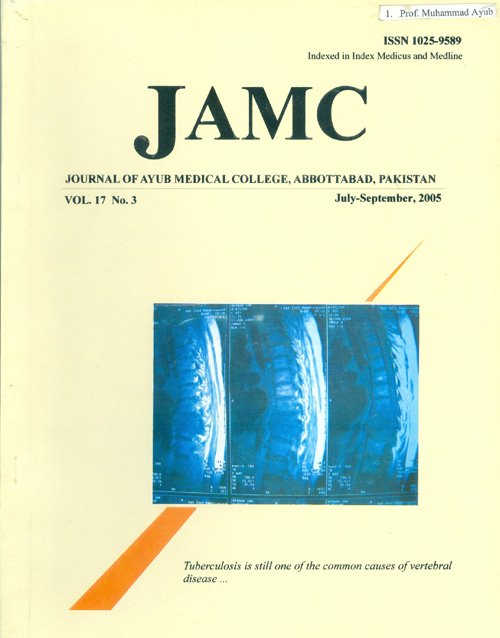MANAGEMENT OUTCOME OF RESIDUAL COMMON BILE DUCT STONES AT AGA KHAN UNIVERSITY HOSPITAL
Abstract
Background: The frequency of residual common bile duct (CBD) stones in patients with previouscholecystectomy ranges from 2-10%, and a minimally invasive approach is generally
recommended for these patients. This study reviews the experience in the management of residual
CBD stones at the Aga Khan University Hospital. Methods: All adult patients diagnosed to have
residual CBD stones, from 1993 to 2001, were identified and analyzed in terms of the treatment
modality utilized and its associated complications. The role of endoscopic sphincterotomy was
particularly analyzed in our set-up. Results: The study population consisted of 66 patients. The
mean age was 52 (range:18-84 years) years with a female to male ratio of 51:15. The primary
mode of management consisted of endoscopic sphincterotomy in 61 patients (92.5%). The initial
clearance rate for these patients was 75%, while the remaining 25% required ancillary procedures
to achieve a complete clearance. Procedure related complications were observed in 17 (28%)
patients, with zero mortality. The other 5 patients (7.5%) underwent an open choledochotomy as a
primary procedure with no further complications. Conclusions: Endoscopic sphincterotomy is the
most frequent treatment modality used for the management of residual CBD stones at our hospital.
Although initial success rate seems low, the fact that endoscopic sphincterotomy is a less invasive
procedure justifies its preferential utilization. The study does not compare the results of
endoscopic management with open surgery, as the number of patients managed by open
choledochotomy is very small.
Keywords: Common bile dust stones, Retained common bile duct stones, Endoscopic
sphincterotomy, Endoscopic retrograde cholangiopancreaticography
References
Pitt AH. Role of Choledochotomy in the Treatment of
Choledocholithiasis. Am J Surg 1993;170:483-6.
Stain SC, Cohen H, Tsuishoysha M, Donovan AJ.
Choledocholithiasis: Endoscopic Sphincterotomy or
Common Bile Duct Exploration. Ann Surg 1991;213:627-34.
Nauhaus H. Prospective Evaluation of the use of endoscopic
retrograde cholangiography prior to laparoscopic
cholecystectomy. Endoscopy 1992;24(9):745-9.
Ludwig K, Bernhardt J, Steffen H, Lorenz D. Contribution of
intraoperative cholangiography to incidence and outcome of
common bile duct injuries during laparoscopic
cholecystectomy. Surg Endosc 2002;16(7):1098-1104.
Flum DR, Koepsell T, Heagerty P, Sinanan M, Dellinger EP.
Common bile duct injury during laparoscopic
cholecystectomy and the use of intraoperative
cholangiography: adverse outcome or preventable error?
Arch Surg 2001;136(11):1287-92.
Thornton DJ, Robertson A, Alexander DJ. Laparoscopic
cholecystectomy without routine intraoperative
cholangiography does not result in significant problems
related to retained stones. Surg Endosc 2002;16(4):592-5.
Neuhaus G. Prospective evaluation of the use of endoscopic
retrograde cholangiography prior to laparoscopic
cholecystectomy. Endoscopy 1992;24:745-9.
Graham SM. Laparoscopic cholecystectomy and common
bile duct stones. Ann Surg 1993;218:61-7.
Braghetto I, Debandi A, Korn O, Bastias J. Long-term follow
up after laparoscopic cholecystectomy without routine
intraoperative cholangiography. Surg Laparosc Endosc
;8(5):349-52.
Vezakis A, Davides D, Ammori B, Martin IG, Larvin M,
McMahon MJ. Intraoperative cholangiography during
J Ayub Med Coll Abbottabad 2005;17(3)
laparoscopic cholecystectomy. Surg Endosc
;14(12):1118-22.
Csendes A. World progress in Surgery: Common bile duct
stones - Introduction. World J Surg 1998;22(11):1113.
Schmitt CM, Baillie J, Cotton PB. ERCP following
laparoscopic cholecystectomy: A safe and effective way to
manage CBD stones and complications. HPB Surgery
;8:187-92.
Fiore NF, Ledniczky G, Wiebke EA, Broadie TA, Pruitt Al,
Goulet RJ et al. An analysis of perioperative cholangiography
in one thousand laparoscopic cholecystectomies. Surgery
;122:817-23.
Rosenthal RJ, Rossi RL, Martin RF. Options and strategies
for the management of choledocholithiasis. World J Surg
;22:1125-32.
Jafri SMW. Approach to the difficult common bile duct
stone. Pakistan J Gastroenterol 1995;9(2):11-4.
Phillips EH, Rosenthal RJ, Carroll BJ, Fallas MJ.
Laparoscopic transcystic common bile duct exploration. Surg
Endosc 1994;8:1389-94.
Kapoor R, Pradeep R, Sikora SS, Saxena R, Kapoor VK,
Kaushik SP. Appraisal of surgical and endoscopic
management of choledocholithiasis. Aust N Z J Surg
;64(9):599-603.
Johnson AS, Ferrara JJ, Steinberg SM, Gassen GM, Hollier
LH, Flint LM. The role of endoscopic retrograde
cholangiopancreaticography: sphincterotomy versus common
bile duct exploration as a primary technique in the
management of choledocholithiasis. Am Surg 1993;59(2):78-
Suc B, Escat J, Cherqui D, Fourtanier G, Hay JM, Fingerhut
A, et al. Surgery vs endoscopy as primary treatment in
symptomatic patients with suspected common bile duct
stones: a multicenter randomized trial. French Association
for Surgical Research. Arch Surg 1998;133(7):702-8.
Kharrat J, Kchaou-Ouakaa A, Bel-Hadj N, Gargouri D,
Kochlef A, Romani M, et al. Endoscopic treatment of
residual lithiasis. 661 cases. Tunis Med 2005;83(1):13-7.
Downloads
How to Cite
Issue
Section
License
Journal of Ayub Medical College, Abbottabad is an OPEN ACCESS JOURNAL which means that all content is FREELY available without charge to all users whether registered with the journal or not. The work published by J Ayub Med Coll Abbottabad is licensed and distributed under the creative commons License CC BY ND Attribution-NoDerivs. Material printed in this journal is OPEN to access, and are FREE for use in academic and research work with proper citation. J Ayub Med Coll Abbottabad accepts only original material for publication with the understanding that except for abstracts, no part of the data has been published or will be submitted for publication elsewhere before appearing in J Ayub Med Coll Abbottabad. The Editorial Board of J Ayub Med Coll Abbottabad makes every effort to ensure the accuracy and authenticity of material printed in J Ayub Med Coll Abbottabad. However, conclusions and statements expressed are views of the authors and do not reflect the opinion/policy of J Ayub Med Coll Abbottabad or the Editorial Board.
USERS are allowed to read, download, copy, distribute, print, search, or link to the full texts of the articles, or use them for any other lawful purpose, without asking prior permission from the publisher or the author. This is in accordance with the BOAI definition of open access.
AUTHORS retain the rights of free downloading/unlimited e-print of full text and sharing/disseminating the article without any restriction, by any means including twitter, scholarly collaboration networks such as ResearchGate, Academia.eu, and social media sites such as Twitter, LinkedIn, Google Scholar and any other professional or academic networking site.










